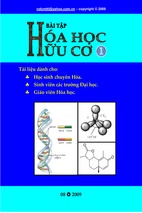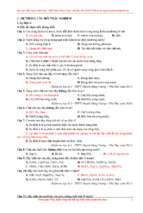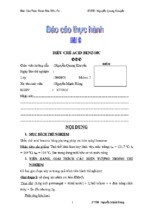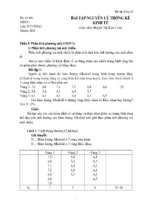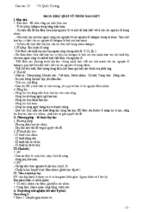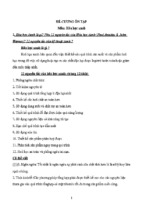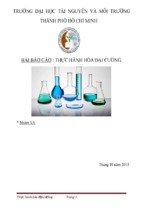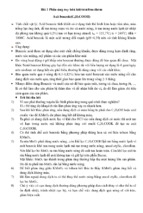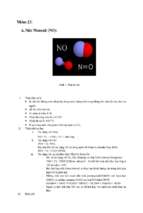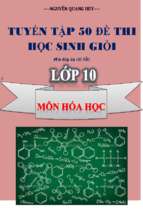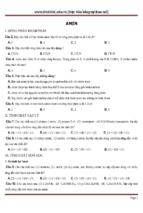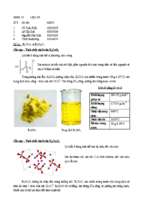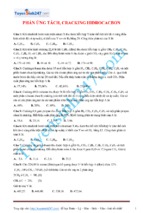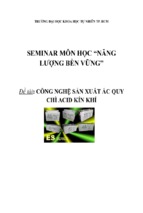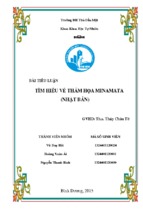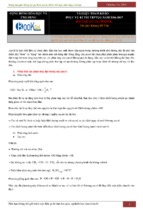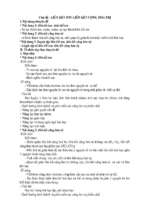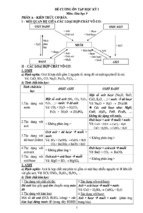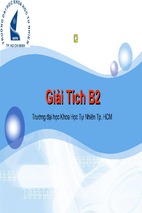Introductory
Chemistry for Today
Seventh Edition
Spencer L. Seager
Weber State University
Michael R. Slabaugh
Weber State University
Australia • Brazil • Japan • Korea • Mexico • Singapore • Spain • United Kingdom • United States
Introductory Chemistry for Today, Seventh
Edition
Spencer L. Seager, Michael R. Slabaugh
Publisher: Charles Hartford
Developmental Editor: Alyssa White
Assistant Editor: Ashley Summers
Editorial Assistant: Jon Olafsson
© 2011, 2008 Brooks/Cole, Cengage Learning
ALL RIGHTS RESERVED. No part of this work covered by the copyright herein
may be reproduced, transmitted, stored, or used in any form or by any means
graphic, electronic, or mechanical, including but not limited to photocopying,
recording, scanning, digitizing, taping, Web distribution, information networks,
or information storage and retrieval systems, except as permitted under
Section 107 or 108 of the 1976 United States Copyright Act, without the prior
written permission of the publisher.
Media Editor: Lisa Weber
Marketing Manager: Nicole Hamm
Marketing Assistant: Kevin Carroll
Marketing Communications Manager: Linda Yip
Content Project Manager: Teresa L. Trego
For product information and technology assistance, contact us at
Cengage Learning Customer & Sales Support, 1-800-354-9706.
For permission to use material from this text or product,
submit all requests online at www.cengage.com/permissions
Further permissions questions can be emailed to
[email protected]
Creative Director: Rob Hugel
Art Director: John Walker
Print Buyer: Rebecca Cross
Rights Acquisitions Account Manager,
Text: Bob Kauser
Rights Acquisitions Account Manager,
Image: Don Schlotman
Production Service: Pre-Press PMG
Text Designer: Ellen Pettengill
Library of Congress Control Number: 2009942740
ISBN-13: 978-0-538-73430-1
ISBN-10: 0-538-73430-2
Brooks/Cole
20 Davis Drive
Belmont, CA 94002-3098
USA
Photo Researcher: The Bill Smith Group
Copy Editor: Denise Rubens
OWL Producers: Stephen Battisti, Cindy Stein,
and David Hart in the Center for Educational
Software Development at the University of
Massachusetts, Amherst, and Cow Town
Productions
Cover Designer: RHDG/Riezebos Holzbaur
Design Group
Cover Image: David Muir/Getty Images
Compositor: Pre-Press PMG
Printed in the United States of America
1 2 3 4 5 6 7 13 12 11 10 09
Cengage Learning is a leading provider of customized learning solutions with
office locations around the globe, including Singapore, the United Kingdom,
Australia, Mexico, Brazil, and Japan. Locate your local office at
www.cengage.com/global.
Cengage Learning products are represented in Canada by Nelson Education, Ltd.
To learn more about Brooks/Cole, visit www.cengage.com/brookscole.
Purchase any of our products at your local college store or at our preferred
online store www.CengageBrain.com.
To our grandchildren:
Nate and Braden Barlow, and Megan and Bradley Seager
Alexander, Annie, Christian, Elyse, Foster, Megan, and Mia Slabaugh, and Hadyn Hansen
This page intentionally left blank
About the Authors
Spencer L. Seager
Spencer L. Seager is a professor of chemistry at Weber State University,
where he served as chemistry department chairman from 1969 until 1993.
He teaches general chemistry at the university and is also active in projects
to help improve chemistry and other science education in local elementary
schools. He received his B.S. degree in chemistry and Ph.D. degree in physical
chemistry from the University of Utah. Other interests include making minor
home repairs, reading history of science and technology, listening to classical
music, and walking for exercise.
Michael R. Slabaugh
Michael R. Slabaugh is a senior fellow at Weber State University, where he teaches
the year-long sequence of general chemistry, organic chemistry, and biochemistry. He
received his B.S. degree in chemistry from Purdue University and his Ph.D. degree
in organic chemistry from Iowa State University. His interest in plant alkaloids led to
a year of postdoctoral study in biochemistry at Texas A&M University. His current
professional interests are chemistry education and community involvement in science
activities, particularly the State Science and Engineering Fair in Utah. He also enjoys
the company of family, hiking in the mountains, and fishing the local streams.
v
This page intentionally left blank
Brief Contents
CHAPTER
1
CHA PTER
Matter, Measurements,
and Calculations 1
CHAPTER
CHAPTER
Solutions and Colloids
CHA PTER
2
Atoms and Molecules
44
CHA PTER
3
CHAPTER
CHA PTER
9
264
10
95
CHA PTER
137
CHA PTER
337
12
Unsaturated Hydrocarbons
6
307
11
Organic Compounds: Alkanes
5
The States of Matter
239
Radioactivity and Nuclear Processes
4
Chemical Reactions
8
Acids, Bases, and Salts
Forces Between Particles
CHAPTER
201
Reaction Rates and Equilibrium
Electronic Structure and
the Periodic Law 68
CHAPTER
7
374
166
vii
This page intentionally left blank
Contents
CHAPTER
1
CHEMISTRY AROUND US 1.1 A Central
Science
Matter, Measurements,
and Calculations 1
1.1
1.2
1.3
1.4
1.5
1.6
1.7
1.8
What Is Matter? 2
Properties and Changes 3
A Model of Matter 5
Classifying Matter 8
Measurement Units 12
The Metric System 13
Large and Small Numbers 18
Significant Figures 22
Using Units in Calculations 26
1.10 Calculating Percentages 28
1.11 Density 30
Concept Summary 34
Key Terms and Concepts 34
Key Equations 35
Exercises 35
Additional Exercises 41
Allied Health Exam Connection 42
Chemistry for Thought 43
Jochen Sands/Digital Vision/Getty Images
1.9
3
CHEMISTRY AROUND US 1.2 Cosmetics: Complex
Mixtures and Complex Regulations
4
CHEMISTRY AROUND US 1.3 Green Chemistry
18
29
CHEMISTRY AND YOUR HEALTH 1.1 Health
Information on the Web 31
AT THE COUNTER 1.1 Nonprescription
Medicines 33
STUDY SKILLS 1.1 Help with Calculations
CHA PTER
2
Atoms and Molecules
2.1
2.2
2.3
2.4
2.5
2.6
2.7
44
Symbols and Formulas 45
Inside the Atom 47
Isotopes 49
Relative Masses of Atoms and Molecules 50
Isotopes and Atomic Weights 54
Avogadro’s Number: The Mole 55
The Mole and Chemical Formulas 59
Concept Summary 62
Key Terms and Concepts 62
Exercises 62
Additional Exercises 65
Allied Health Exam Connection 66
Chemistry for Thought 67
CHEMISTRY AROUND US 2.1 Diamonds:
From Gems to iPods 48
AT THE COUNTER 2.1 Calcium Supplements:
Which Type Is Best? 51
CHEMISTRY AND YOUR HEALTH 2.1 Are You at
Risk for Osteoporosis? 52
STUDY SKILLS 2.1 Help with Mole
Calculations 60
CHA PTER
3
Electronic Structure and
the Periodic Law 68
3.1
3.2
3.3
The Periodic Law and Table 69
Electronic Arrangements in Atoms 71
The Shell Model and Chemical Properties 74
ix
Electronic Configurations 76
3.5 Another Look at the Periodic Table 80
3.6 Property Trends within the Periodic Table
Concept Summary 89
Key Terms and Concepts 90
Exercises 90
Additional Exercises 93
Allied Health Exam Connection 93
Chemistry for Thought 94
3.4
CHA PTER
Chemical Reactions 137
84
Chemical Equations 138
Types of Reactions 139
5.3 Redox Reactions 140
5.4 Decomposition Reactions 145
5.5 Combination Reactions 145
5.6 Replacement Reactions 146
5.7 Ionic Equations 149
5.8 Energy and Reactions 150
5.9 The Mole and Chemical Equations 151
5.10 The Limiting Reactant 154
5.11 Reaction Yields 156
Concept Summary 157
Key Terms and Concepts 158
Key Equations 158
Exercises 159
Additional Exercises 163
Allied Health Exam Connection 163
Chemistry for Thought 165
AT THE COUNTER 5.1 Antiseptics and
Disinfectants 144
CHEMISTRY AND YOUR HEALTH 5.1 The
Importance of Color in Your Diet 148
CHEMISTRY AROUND US 5.1 Ozone: The Good and
The Bad 151
CHEMISTRY AROUND US 5.2 Air Bag
Chemistry 155
STUDY SKILLS 5.1 Help with Oxidation Numbers 156
5.1
5.2
AT THE COUNTER 3.1 Zinc for Colds? The Jury
Is Still Out
71
CHEMISTRY AROUND US 3.1 Nano World
79
STUDY SKILLS 3.1 The Convention Hotels
Analogy
81
CHEMISTRY AND YOUR HEALTH 3.1 Protecting
Children from Iron Poisoning 85
CHA P T E R
4
Forces Between Particles 95
Noble Gas Configurations 96
Ionic Bonding 98
4.3 Ionic Compounds 100
4.4 Naming Binary Ionic Compounds 102
4.5 The Smallest Unit of Ionic Compounds 104
4.6 Covalent Bonding 105
4.7 Polyatomic Ions 110
4.8 Shapes of Molecules and Polyatomic Ions 112
4.9 The Polarity of Covalent Molecules 117
4.10 More about Naming Compounds 120
4.11 Other Interparticle Forces 123
Concept Summary 129
Key Terms and Concepts 129
Exercises 130
Additional Exercises 134
Allied Health Exam Connection 135
Chemistry for Thought 136
CHEMISTRY AND YOUR HEALTH 4.1 Fight
Hypertension With Potassium 101
CHEMISTRY AROUND US 4.1 Water: One of Earth’s
Special Compounds 106
AT THE COUNTER 4.1 Versatile Zinc Oxide 117
STUDY SKILLS 4.1 Help with Polar and Nonpolar
Molecules 122
CHEMISTRY AROUND US 4.2 Nitric Oxide:
A Simple but Vital Biological Molecule 125
4.1
Contents
Jim West/PhotoLibrary
4.2
x
5
CHAPTER
The States of Matter
6.1
AT THE COUNTER 6.1 Cutting Drug Costs with
6
Generics
166
186
CHEMISTRY AROUND US 6.2 Therapeutic Uses of
Oxygen Gas 189
STUDY SKILLS 6.1 Which Gas Law to Use 191
CHEMISTRY AROUND US 6.1 Sweating It Out
Observed Properties of Matter 167
The Kinetic Molecular Theory of Matter 169
The Solid State 171
6.4 The Liquid State 171
6.5 The Gaseous State 172
6.6 The Gas Laws 173
6.7 Pressure, Temperature, and Volume
Relationships 176
6.8 The Ideal Gas Law 180
6.9 Dalton’s Law 182
6.10 Graham’s Law 183
6.11 Changes in State 184
6.12 Evaporation and Vapor Pressure 184
6.13 Boiling and the Boiling Point 186
6.14 Sublimation and Melting 187
6.15 Energy and the States of Matter 188
Concept Summary 192
Key Terms and Concepts 193
Key Equations 193
Exercises 194
Additional Exercises 198
Allied Health Exam Connection 198
Chemistry for Thought 200
CHEMISTRY AND YOUR HEALTH 6.1 Huffing:
A Potential Introduction of Children to Drug
Abuse 175
180
6.2
6.3
CHA PTER
7
Solutions and Colloids
7.1
7.2
7.3
7.4
7.5
7.6
7.7
7.8
7.9
201
Physical States of Solutions 202
Solubility 203
The Solution Process 207
Solution Concentrations 211
Solution Preparation 215
Solution Stoichiometry 218
Solution Properties 220
Colloids 226
Dialysis 228
Concept Summary 230
Key Terms and Concepts 231
Key Equations 231
Exercises 231
Additional Exercises 236
Allied Health Exam Connection 236
Chemistry for Thought 238
AT THE COUNTER 7.1 Oral Rehydration
Therapy 210
CHEMISTRY AND YOUR HEALTH 7.1 The Risk of
Dehydration During Vigorous Youth Activities 213
STUDY SKILLS 7.1 Getting Started with Molarity
Calculations 224
CHEMISTRY AROUND US 7.1 Tears: Solutions for
Many Eye Problems 227
CHEMISTRY AROUND US 7.2 Global Warming and
a Cooler Europe 229
CHA PTER
8
Reaction Rates and Equilibrium
3660 Group Inc./Custom Medical Stock Photo
8.1
8.2
8.3
8.4
8.5
8.6
239
Spontaneous and Nonspontaneous Processes 240
Reaction Rates 242
Molecular Collisions 242
Energy Diagrams 245
Factors That Influence Reaction Rates 246
Chemical Equilibrium 248
Contents
xi
The Position of Equilibrium 250
8.8 Factors That Influence Equilibrium Position
Concept Summary 256
Key Terms and Concepts 256
Key Equations 257
Exercises 257
Additional Exercises 261
Allied Health Exam Connection 261
Chemistry for Thought 263
8.7
CHA PTER
252
Radioactivity and Nuclear
Processes 307
10.1
10.2
10.3
10.4
10.5
AT THE COUNTER 8.1 Timed-Release
Medications
10.6
243
10.7
CHEMISTRY AND YOUR HEALTH 8.1 Hypothermia:
Surviving the Big Chill
10.8
249
10.9
CHEMISTRY AROUND US 8.1 The True Value of
Platinum and Gold
253
STUDY SKILLS 8.1 Le Châtelier’s Principle in
Everyday Life
CHA P T E R
256
9
Acids, Bases, and Salts
264
The Arrhenius Theory 265
The Brønsted Theory 265
9.3 Naming Acids 267
9.4 The Self-Ionization of Water 268
9.5 The pH Concept 271
9.6 Properties of Acids 274
9.7 Properties of Bases 277
9.8 Salts 278
9.9 The Strengths of Acids and Bases 281
9.10 Analyzing Acids and Bases 287
9.11 Titration Calculations 289
9.12 Hydrolysis Reactions of Salts 291
9.13 Buffers 292
Concept Summary 296
Key Terms and Concepts 297
Key Equations 297
Exercises 297
Additional Exercises 304
Allied Health Exam Connection 305
Chemistry for Thought 306
CHEMISTRY AROUND US 9.1 Beware the Negative
Effects of Acids on Teeth 282
STUDY SKILLS 9.1 Writing Reactions of Acids 286
CHEMISTRY AND YOUR HEALTH 9.1 Do You Have
Acid Reflux Disease? 287
AT THE COUNTER 9.1 Heartburn Remedies:
Something Old, Something New 295
9.1
Contents
Radioactive Nuclei 308
Equations for Nuclear Reactions 309
Isotope Half-Life 312
The Health Effects of Radiation 314
Measurement Units for Radiation 316
Medical Uses of Radioisotopes 319
Nonmedical Uses of Radioisotopes 320
Induced Nuclear Reactions 322
Nuclear Energy 325
Concept Summary 330
Key Terms and Concepts 331
Key Equations 331
Exercises 332
Additional Exercises 334
Allied Health Exam Connection 334
Chemistry for Thought 336
CHEMISTRY AROUND US 10.1 Medical
9.2
xii
10
Imaging
317
CHEMISTRY AROUND US 10.2 Radon: A
Chemically Inert Health Risk
321
CHEMISTRY AND YOUR HEALTH 10.1 Is Irradiated
Food Safe?
328
AT THE COUNTER 10.1 The Do’s and Don’ts of
© Pete Saloutos/CORBIS
Buying Prescription Drugs Online
330
CHAPTER
11
Organic Compounds: Alkanes
CHEMISTRY AROUND US 11.2 Ice Storms and
Deadly Carbon Monoxide 365
337
Carbon: The Element of Organic Compounds 338
11.2 Organic and Inorganic Compounds Compared 339
11.3 Bonding Characteristics and Isomerism 341
11.4 Functional Groups: The Organization of Organic
Chemistry 343
11.5 Alkane Structures 346
11.6 Conformations of Alkanes 349
11.7 Alkane Nomenclature 351
11.8 Cycloalkanes 357
11.9 The Shape of Cycloalkanes 359
11.10 Physical Properties of Alkanes 362
11.11 Alkane Reactions 364
Concept Summary 366
Key Terms and Concepts 366
Key Reactions 367
Exercises 367
Additional Exercises 372
Allied Health Exam Connection 372
Chemistry for Thought 373
STUDY SKILLS 11.1 Changing Gears for Organic
Chemistry 340
CHEMISTRY AND YOUR HEALTH 11.1 Organic
Foods: Are They Safer? More Nutritious? 347
CHEMISTRY AROUND US 11.1 Petroleum: Gold in
Your Tank 362
AT THE COUNTER 11.1 Skin Moisturizers: Choosing
One That Works 364
11.1
CHA PTER
12
Unsaturated Hydrocarbons
12.1
12.2
12.3
12.4
12.5
12.6
12.7
12.8
374
The Nomenclature of Alkenes 375
The Geometry of Alkenes 379
Properties of Alkenes 382
Addition Polymers 387
Alkynes 391
Aromatic Compounds and the Benzene Structure 392
The Nomenclature of Benzene Derivatives 394
Properties and Uses of Aromatic Compounds 397
Concept Summary 400
Key Terms and Concepts 400
Key Reactions 400
Exercises 401
Additional Exercises 405
Allied Health Exam Connection 405
Chemistry for Thought 405
CHEMISTRY AROUND US 12.1 Watermelon: A
Source of Lycopene 377
CHEMISTRY AROUND US 12.2 Seeing the Light 380
STUDY SKILLS 12.1 Keeping a Reaction Card
File 386
STUDY SKILLS 12.2 A Reaction Map for
Alkenes 389
HOW REACTIONS OCCUR 12.1 The Hydration of
Alkenes: An Addition Reaction 392
CHEMISTRY AND YOUR HEALTH 12.1 Beautiful,
Brown ... and Overdone 395
AT THE COUNTER 12.1 Smoking: It’s Quitting
Time 398
Appendix A The International System
of Measurements A-1
Appendix B Answers to Even-Numbered
End-of-Chapter Exercises B-1
Appendix C Solutions to Learning Checks
Glossary
G-1
I-1
© Guy Cali/Corbis
Index
C-1
Contents
xiii
Preface
The Image of Chemistry
We, as authors, are pleased that the acceptance of the previous six editions of this textbook
by students and their teachers has made it possible to publish this seventh edition. In the
earlier editions, we expressed our concern about the negative image of chemistry held by
many of our students, and their genuine fear of working with chemicals in the laboratory.
Unfortunately, this negative image not only persists, but seems to be intensifying. Reports
in the media related to chemicals or to chemistry continue to be primarily negative, and
in many cases seem to be designed to increase the fear and concern of the general public.
With this edition, we continue to hope that those who use this book will gain a more positive understanding and appreciation of the important contributions that chemistry makes
in their lives.
Theme and Organization
This edition continues the theme of the positive and useful contributions made by chemistry
in our world. Consistent with that theme, we continue to use the chapter opening focus on
health care professionals introduced in the second edition. The photos and accompanying
brief descriptions of the role of chemistry in each profession continue to emphasize positive contributions of chemistry in our lives.
This text is designed to be used in either a two-semester or three-quarter course of study
that provides an introduction to general chemistry, organic chemistry, and biochemistry.
Most students who take such courses are majoring in nursing, other health professions, or
the life sciences, and consider biochemistry to be the most relevant part of the course of
study. However, an understanding of biochemistry depends upon a sound background in
organic chemistry, which in turn depends upon a good foundation in general chemistry.
We have attempted to present the general and organic chemistry in sufficient depth and
breadth to make the biochemistry understandable.
As with previous editions, this textbook is published in a complete hardcover form and
a two-volume paperback edition. One volume of the paperback edition contains all the
general chemistry and the first two chapters of organic chemistry from the hardcover text.
The second volume of the paperback edition contains all the organic chemistry and biochemistry of the hardcover edition. The availability of the textbook in these various forms
has been a very popular feature among those who use the text because of the flexibility it
affords them.
The decisions about what to include and what to omit from the text were based on our
combined 70-plus years of teaching, input from numerous reviewers and adopters, and
our philosophy that a textbook functions as a personal tutor to each student. In the role
of a personal tutor, a text must be more than just a collection of facts, data, and exercises.
It should also help students relate to the material they are studying, carefully guide them
through more difficult material, provide them with interesting and relevant examples of
chemistry in their lives, and become a reference and a resource that they can use in other
courses or their professions.
xv
New to This Edition
In this seventh edition of the text, we have retained features that received a positive reception
from our own students, the students of other adopters, other teachers, and reviewers. The
retained features are 24 Study Skills boxes that include 5 reaction maps; 4 How Reactions
Occur boxes; 44 Chemistry Around Us boxes, including 19 new to this edition. The former
feature Over The Counter has been changed to At The Counter and reflects coverage of both
prescription and non-prescription health-related products. Twelve of the 24 At The Counter
boxes are new to this edition. There are 22 Chemistry and Your Health boxes, with 8 new
to this edition. A greatly expanded feature of this seventh edition is the Allied Health Exam
Connection that follows the exercises at the end of each chapter. This feature consists of
examples of chemistry questions found on typical entrance examinations used to screen
applicants to allied health professional programs. In addition, approximately 20% of the
end-of-chapter exercises have been changed.
d. 22
Allied Health Exam Connection
5.72 What is the oxidation number for nitrogen in HNO3?
The following questions are from these sources:
1. Nursing School Entrance Exam © 2005, Learning Express, LLC.
a. 22
2. McGraw-Hill’s Nursing School Entrance Exams by Thomas
A. Evangelist, Tamara B. Orr and Judy Unrein © 2009, The
McGraw-Hill Companies, Inc.
b. 15
c. 21
d. 25
3. NSEE Nursing School Entrance Exams, 3rd Edition © 2009,
Kaplan Publishing.
5.73 The oxidation number of sulfur in the ion SO422 is:
4. Cliffs Test Prep: Nursing School Entrance Exams by Fred N. Grayson
© 2004, Wiley Publishing, Inc.
5. Peterson’s Master the Nursing School and Allied Health Entrance
Exams, 18th Edition by Marion F. Gooding © 2008, Peterson’s,
a Nelnet Company.
5.66 Balance the following redox reaction:
Mg(s) 1 H2O(g) S Mg(OH)2(s) 1 H2(g)
c. 16
d. 110
5.74 Which of the following is the oxidation number of sulfur in the
compound sodium thiosulfate, Na2S2O3?
a. 11
a. Mg(s) 1 H2O(g) S Mg(OH)2(s) 1 H2(g)
b. 21
b. Mg(s) 1 4H2O(g) S Mg(OH)2(s) 1 H2(g)
c. 12
c. Mg(s) 1 2H2O(g) S Mg(OH)2(s) 1 H2(g)
d. Mg(s) 1 H2O(g) S Mg(OH)2(s) 1
a. 22
b. 12
d. 22
1
2 H2(g)
5.75 Which best describes the following redox reaction:
2
Also new to this edition are many new photographs and updated art to further enhance
student comprehension of key concepts, processes and preparation.
+
–
33322_05_Ch05_p137-165_pp2.indd
163
11/13/09 10:35:12 AM
+
+
–
© Dr. E. R. Degginger
© Dr. E. R. Degginger
© Dr. E. R. Degginger
+
–
+
Step 1. Put 0.125 mol of solute into a
250-mL flask.
–
+
+
1
–
+
+
–
+
+
–
–
+
+
+
–
–
+
+
–
+
+
–
–
–
+
+
–
–
–
+
+
–
–
+
+
–
–
+
–
–
+
–
+
+
–
2
Step 2. Add some water and dissolve
the solute.
3
Step 3. Fill the flask to the mark with
water. Mix thoroughly.
Figure 7.8 Preparation of a 0.500 M solution. Use the data given in the figure and show by
a calculation that the resulting solution is 0.500 M.
33322_07_Ch07_p201-238_pp2.indd 215
xvi
Preface
11/27/09 3:49:09 PM
Revision Summary of Seventh Edition:
Chapter 1:
•
•
•
•
•
•
Several revised figures
New photography
Revised Examples
New Chemistry Around Us: Green Chemistry
20% new Exercises
Numerous new Allied Health Connection Questions
Chapter 2:
•
•
•
•
•
•
Several revised figures
New photography
Revised and new Examples
New At the Counter: Calcium Supplements: Which Type is Best?
20% new Exercisese
Numerous new Allied Health Connection Questions
Chapter 3:
•
•
•
•
Several revised figures
New photography
20% new Exercisese
Numerous new Allied Health Connection Questions
Chapter 4:
•
•
•
•
•
•
Several revised figures
New photography
Revised Examples
New Chemistry and Your Health: Fight Hypertension with Potassium
20% new Exercises
Numerous new Allied Health Connection Questions
Chapter 5:
•
•
•
•
•
•
Several revised figures
New photography
Revised and new Examples
New Chemistry Around Us: Ozone: The Good and the Bad
20% new Exercises
Numerous new Allied Health Connection Questions
Chapter 6:
• Several revised figures
• New photography
• New Chemistry and Your Health: Huffing: A Potential Introduction of Children to
Drug Abuse
• New At the Counter: Cutting Drug Costs with Generics
• 20% new Exercises
• Numerous new Allied Health Connection Questions
Chapter 7:
•
•
•
•
Several revised figures
New photography
Revised and new Examples
New Chemistry and Your Health: The Risk of Dehydration During Vigorous Youth
Activities
• 20% new Exercises
• Numerous new Allied Health Connection Questions
Preface
xvii
Chapter 8:
•
•
•
•
•
•
Several revised figures
New photography
New Chemistry and Your Health: Hypothermia: Surviving the Big Chill
New Chemistry Around Us: The True Value of Platinum and Gold
20% new Exercises
Numerous new Allied Health Connection Questions
Chapter 9:
•
•
•
•
•
•
Several revised figures
New photography
Revised Examples
New Chemistry Around Us: Beware the Negative Effects of Acids on Teeth
20% new Exercises
Numerous new Allied Health Connection Questions
Chapter 10:
•
•
•
•
•
Several revised figures
New photography
New At the Counter: The Do’s and Don’ts of Buying Prescription Drugs Online
20% new Exercises
Numerous new Allied Health Connection Questions
Chapter 11:
•
•
•
•
Several revised figures
New photography
20% new Exercises
Numerous new Allied Health Connection Questions
Chapter 12:
•
•
•
•
Several revised figures
New photography
20% new Exercises
Numerous new Allied Health Connection Questions
Features
6
The States of Matter
Each chapter has features especially designed to help students study effectively,
as well as organize, understand, and enjoy the material in the course.
Learning Objectives
When you have completed your study
of this chapter, you should be able to:
1 Do calculations based on the
property of density. (Section 6.1)
2 Demonstrate an understanding
of the kinetic molecular theory of
matter. (Sections 6.2–6.4)
3 Use the kinetic molecular theory
to explain and compare the properties of matter in different states.
Chapter Opening Photos. Each chapter opens with a photo of one of the many
health care professionals that provide us with needed services. These professionals
represent some of the numerous professions that require an understanding of
chemistry.
(Section 6.5)
4 Do calculations to convert pressure
and temperature values into various
units. (Section 6.6)
5 Do calculations based on Boyle’s law,
Charles’s law, and the combined gas
law. (Section 6.7)
6 Do calculations based on the ideal
gas law. (Section 6.8)
7 Do calculations based on Dalton’s
law. (Section 6.9)
8 Do calculations based on Graham’s
law. (Section 6.10)
9 Classify changes of state as exothermic or endothermic. (Section 6.11)
10 Demonstrate an understanding of
the concepts of vapor pressure and
evaporation. (Section 6.12)
11 Demonstrate an understanding of
the process of boiling and the concept of boiling point. (Section 6.13)
12 Demonstrate an understanding of
the processes of sublimation and
melting. (Section 6.14)
13 Do calculations based on energy
changes that accompany heating,
cooling, or changing the state of
a substance. (Section 6.15)
Online homework for this chapter
may be assigned in OWL.
Chapter Outlines and Learning Objectives. At the beginning of each chapter,
a list of learning objectives provides students with a convenient overview of
what they should gain by studying the chapter. In order to help students navigate
through each chapter and focus on key concepts, these objectives are repeated
at the beginning of the section in which the applicable information is discussed.
The objectives are referred to again in the concept summary at the end of each
chapter along with one or two suggested end-of-chapter exercises. By working
the suggested exercises, students get a quick indication of how well they have
met the stated learning objectives. Thus, students begin each chapter with a set of
objectives and end with an indication of how well they satisfied the objectives.
Respiratory therapists assist in both the
treatment and diagnostic testing of pulmonary function. They dispense gases,
vapors, and drug-containing therapeutic aerosols to patients. They also use
devices such as a spirometer to measure
lung capacity. Gaseous behavior, as represented by the gas laws of this chapter,
is an important part of their training.
© Jeff Kaufman/Taxi
33322_06_Ch06_p166-200_pp2.indd 166
xviii
Preface
11/11/09 11:48:03 AM
Key Terms. Identified within the text by the use of bold type, key terms are
defined in the margin near the place where they are introduced. Students reviewing
a chapter can quickly identify the important concepts on each page with this
marginal glossary. A full glossary of key terms and concepts appears at the end of
the text.
At the Counter. These boxed features contain useful information about health-related
products that are readily available to consumers with or without a prescription. The
information in each box provides a connection between the chemical behavior of the
product and its effect on the body.
At The Counter 2.1
Calcium Supplements: Which Type Is Best?
In a nutritional context, a supplement provides an amount of a
substance that is in addition to the amount normally obtained from
the diet.
About 99% of the calcium in the body is used to build bones
and teeth. During a lifetime, all bones of the body undergo a natural process of buildup and breakdown. The rate of buildup exceeds
the rate of breakdown for the first 25–30 years of life for women and
the first 30–35 years of life for men. Beyond these times, the rate of
breakdown exceeds the rate of buildup, resulting in a gradual decrease
in bone density. Consequently, bones become increasingly weakened,
brittle, and susceptible to breaking—a condition called osteoporosis.
About 50% of women and 13% of men over age 50 suffer a broken
bone as a result of osteoporosis.
One of the best ways to reduce the risks associated with osteoporosis is to build as much bone as possible during early life when the rate
If a calcium supplement is needed, which type
is best? Most supplements will contain calcium in one of the following
three chemical forms: calcium carbonate (often from oyster shells),
calcium citrate or calcium phosphate. It really makes little difference
which of these three chemical forms the calcium is in, as all three are
absorbed quite well by the body. The important factor in a supplement is the amount of calcium contained in each dose. This amount
per dose is generally indicated on the label and typically ranges from
333 mg to 630 mg. The maximum benefit from calcium supplements
is obtained when the individual dosage is 500 mg or less. So, supplements with individual dosages greater than 500 mg should be divided
and taken in portions throughout the day. An additional consideration
is that vitamin D is essential for maximum calcium absorption by the
body. For this reason, many calcium supplements include vitamin D in
their formulation, and clearly indicate this on their labels.
Chemistry Around Us. These boxed features present everyday applications of chemistry
that emphasize in a real way the important role of chemistry in our lives. Forty percent of
these are new to this edition and emphasize health-related applications of chemistry.
Chemistry and Your Health. These boxed features contain current chemistry-related health
issues such as “The Importance of Color in Your Diet,” and questions about topics such
as safety concerns surrounding genetically modified foods and the relationship between
C-reactive protein and heart disease.
Chemistry and Your Health 5.1
The Importance of Color in Your Diet
Scientific evidence accumulated during the 1990s suggested that diets
rich in fruits and vegetables had a protective effect against a number
of different types of cancer. Studies showed that simply increasing the
levels of vitamins and minerals in the diet did not provide the increased
protection. This led to research into the nature of other substances
found in fruits and vegetables that are important for good health. As
a result of this research, a number of chemical compounds found in
plants and called phytonutrients have been shown to be involved in the
maintenance of healthy tissues and organs. The mechanism for their
beneficial action in the body is not understood for all phytonutrients,
but a significant number are known to work as antioxidants that stop
harmful oxidation reactions from occurring.
The colors of fruits and vegetables help identify
those containing beneficial compounds. The table below contains a list
of some of the more well-known phytonutrients together with sources,
colors, and beneficial actions. The amount of evidence supporting the
existence of benefits from phytonutrients is not the same for all those
listed in the table. In some cases, the experimental evidence is extensive (e.g., the cancer-blocking behavior of isothiocyanates), while
in other cases the listed benefits are based on a limited amount of
research and more studies are being done (e.g., the contribution to eye
health by anthocyanins).
Fruit/Vegetable Examples
Phytonutrients
Possible Benefits
Red
Tomatoes, watermelon, pink
grapefruit
Lycopene (a carotenoid)
Protect against prostate, cervical,
and pancreatic cancer and heart and
lung disease
© iStockphoto.com/
DNY59
Fruit/Vegetable Color
33322_02_Ch02_p044-067_pp2.Indd 51
11/11/09 11:00:17 AM
Examples. To reinforce students in their problem-solving skill development, complete
step-by-step solutions for numerous examples are included in each chapter.
Learning Checks. Short self-check exercises follow examples and discussions of key or
difficult concepts. A complete set of solutions is included in Appendix C. These allow
students to measure immediately their understanding and progress.
Preface
xix
Study Skills. Most chapters contain a Study Skills feature in which a challenging topic,
skill, or concept of the chapter is addressed. Study suggestions, analogies, and approaches
are provided to help students master these ideas.
Study Skills 14.1 A Reaction Map for Aldehydes and Ketones
This reaction map is designed to help you master organic reactions.
Whenever you are trying to complete an organic reaction, use these
two basic steps: (1) Identify the functional group that is to react,
and (2) identify the reagent that is to react with the functional
group. If the reacting functional group is an aldehyde or a ketone,
find the reagent in the summary diagram, and use the diagram to
predict the correct products.
Aldehyde or Ketone
H2, Pt
(O)
Oxidation
If
aldehyde
Carboxylic
acid
alcohol
Hemi formation
Hydrogenation
If
ketone
No
reaction
If
aldehyde
Primary
alcohol
If
ketone
Secondary
alcohol
If
aldehyde
If
ketone
Hemiacetal
Hemiketal
alcohol
Acetal
Ketal
How Reactions Occur. The mechanisms of representative organic reactions are presented in
four boxed inserts to help students dispel the mystery of how these reactions take place.
Concept Summary. Located at the end of each chapter, this feature provides a concise
review of the concepts and includes suggested exercises to check achievement of the
learning objectives related to the concepts.
33322_14_Ch14_p438-465_pp2.indd 452
11/16/09 12:02:11 PM
Concept Summary
Symbols and Formulas. Symbols based on names have been
assigned to every element. Most consist of a single capital letter followed
by a lowercase letter. A few consist of a single capital letter. Compounds
are represented by formulas made up of elemental symbols. The number of atoms of each element in a molecule is shown by subscripts.
tabulated in the periodic table. The units used are atomic mass units,
abbreviated u. Relative masses for molecules, called molecular
weights, are determined by adding the atomic weights of the atoms
making up the molecules.
Objective 1, Exercise 2.4
Isotopes and Atomic Weights. The atomic weights measured
for elements are average weights that depend on the percentages
and masses of the isotopes in the naturally occurring element. If the
isotope percent abundances and isotope masses are known for an element, its atomic weight can be calculated.
Inside the Atom. Atoms are made up of numerous smaller particles of which the most important to chemical studies are the proton,
neutron, and electron. Positively charged protons and neutral neutrons
have a relative mass of 1 u each and are located in the nuclei of atoms.
Negatively charged electrons with a mass of 1/1836 u are located outside the nuclei of atoms.
Objective 2, Exercises 2.10 and 2.12
Isotopes. Most elements in their natural state are made up of more
than one kind of atom. These different kinds of atoms of a specific element are called isotopes and differ from one another only in the number
of neutrons in their nuclei. A symbol incorporating atomic number, mass
number, and elemental symbol is used to represent specific isotopes.
Objective 3, Exercises 2.16 and 2.22
Relative Masses of Atoms and Molecules. Relative masses
Objective 4, Exercise 2.32
Objective 5, Exercise 2.38
Avogadro’s Number: The Mole. Avogadro’s number of the atoms
of an element has a mass in grams equal to the atomic weight of the
element. Avogadro’s number of molecules has a mass in grams equal
to the molecular weight. Avogadro’s number of particles is called a
mole, abbreviated mol.
Objective 6, Exercises 2.44 a & b and 2.46 a & b
The Mole and Chemical Formulas. The mole concept when
applied to molecular formulas gives numerous relationships that yield
useful factors for factor-unit calculations.
Key Terms and Concepts. These are listed at the end of the chapter for easy review,
with a reference to the chapter section in which they are presented.
Key Equations. This feature provides a useful summary of general equations and reactions
from the chapter. This feature is particularly helpful to students in the organic chemistry
chapters.
xx
Preface

